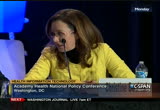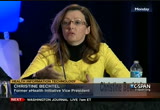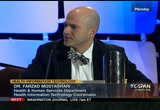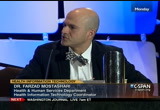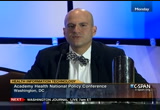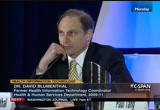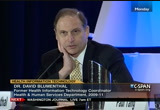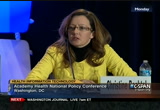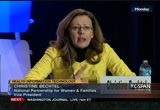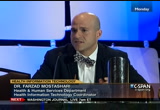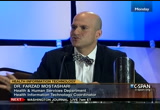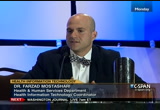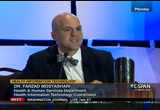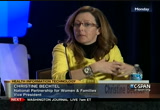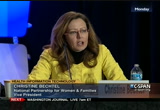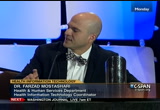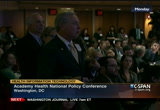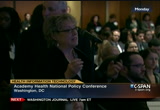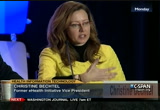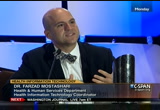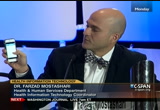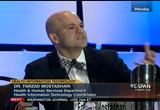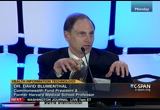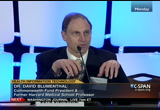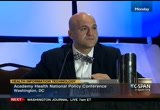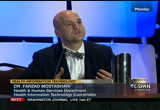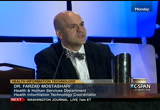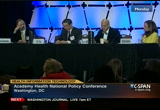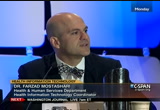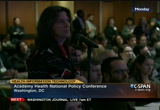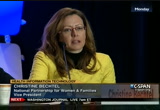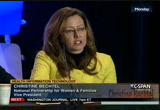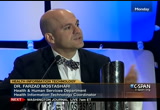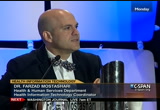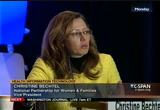tv Politics Public Policy Today CSPAN February 5, 2013 6:00am-7:00am EST
6:00 am
tech? >> it feels like we are in a transition phase and the transition of the aca tie tech and increased expectations about what health information technology can do now -- i think it is a challenge always to balance the technology that can do these things -- we know you don't get paid to do these things but we wanted to do them -- and how those broader dynamics moved down the path and stay connected and yet balance in real time. i think that is a challenge. from the consumer viewpoint and what we know is that consumers want thatit. we did a survey about a year ago and there was broad consumer support for physicians use of electronic of records. i think it has the potential to be a game changer for them. their expectations are now beginning to change, too, in
6:01 am
this transition phase. we saw that only a fairly small percentage of consumers have on- line access to their medical records. it is about 26% of people who also had said in ehr. for those that did, their views were very different and their experiences were very different. there were more engaged in their care and more motivated to do something to improve their care and they felt more confident in their clinician's ability to manage their care with them and began to really set up more of a partnership constructs. it will be very interesting to see end stage 2, where the requirement will be applicable -- applicable the chicken go on line and you can download and you can transmit and i think that will be interesting. from the consumer viewpoint, we are at a point where they are
6:02 am
experiencing some tangible benefits. it is early in the program and that is fabulous. i think what is about to happen will the transformational. >> there is one allegation related to electronic health records of which is that by making it easier to bill and maybe by jazzing up the billing a little bit, electronic health records are actually increasing the cost of care, not reducing the cost of care. they say that will be part of the problem, not part of the solution. what is your response to that? >> we have to separate two issues. one is fraud. if someone is documented care that did not occur, whether
6:03 am
electronic or not, that is fraud. what the secretary and the attorney general have said is we will take that very seriously. the electronic help records give us tools now to be able to audit and investigate and prosecute fraud in ways we never had before. this second category is just using electronic health records as tools. within the given rules of the road. i think that is a more challenging issue to look at. these trends, as reported, have been going on for a decade in terms of the shift in billing patterns and there is met regulatory approaches that cms has to deal with the shift in the patterns of billing intensity codes. we have asked the health policy it committee to see if there are things we can do to minimize
6:04 am
inappropriate use of the records but fundamentally, we've got to change how we pay for care. the comfort is not electronic health records but a system of reimbursement that says you will be paid based on how many visits you can squeeze in and how many elements you can document as quickly as possible regardless of the outcomes of that care and the patient components. i don't think there is any of events -- any evidence on the net balance electronic health records that this has increased the cost of care. it gets to the cost issue. what is our theory of the case of how electronic help records will reduce costs? it has to be within the context
6:05 am
of how health care is paid for them didn't the rand study say that electronic health records are increasing the cost of care? isn't that what the article said? >> as david knows well, that is not all what the rand said it said there are some journalists that misread, perhaps, the counter that way. >> to expand on that a little bit, the rand study actually said they had predicted dramatic reductions in the cost of care and their predictions were wrong. is that correct? >> i thought the random article itself written by art kellerman was a thoughtful piece. what it actually said was that
6:06 am
when the improvements in cost will occur are not after you read a paper or even have to pass a law. it is that you get 90% of adoption of electronic health records and interoperable guilty and they give us credit for progress on that. after you left patients get the data and when you pay for care differently. that is what the rand study, if you read the article as few journalists apparently dead [laughter] that is what the study actually says. it is not really a study because there is no real data analysis. it is a prospective peace. -- is a prospective peace. -- perspective piece. you guys here are about understanding that money may
6:07 am
talk but information is power and data matters, evidence matters. it matters what they said. it matters what they actually found per it matters what the data says. i think that is something that is sometimes lost in the public discourse. people are more interested in writing about what the news article said rather than what the research shows. you serve a critical role in keeping the discourse honest. that is sometimes a tough task. >> let me switch perspective a little bit right now. and turned to christine. there has been an interesting discussion in the lay press about european vs. american privacy laws. for those of you who are not
6:08 am
absorbed by this kind of discussion, it is a little bit arcane, but they said that the european union has a comprehensive set of commercial privacy regulations and the united states has something else. this is not irrelevant to the questions we are discussing because a lot of what we are concerned about in high-tech and chr policy are similar. one of the points of discussion has been, with respect to high tech and implementation, whether we have gotten interrupt ability that was expected and promised. can you talk a little bit, christine, about where we are with respect to the privacy and security protections that we would like to have in place to create the interoperable to we are all looking for?
6:09 am
>> it is a complex issue in terms of the way consumers of view it. we have a brand new final omnibus privacy role that just came out. it has some terrific advancements for consumers. it will address some of the things i think made many of us think twice about electronic records when you go to the doctor for an exam and you get marketing materials a couple of days letter that worse this -- that were suspicious was specific to what you were there for. those types of practices are going to be less and less amongst others. i think that is a terrific advancement. from a consumer viewpoint, when you ask consumers if they are worried that electronic shelf records will lead to more breaches, they say yes, absolutely. when you asked those consumers to have a physician that has an electronic record and, even
6:10 am
better, if they have on-line access to that record and some level of transparency, their levels of trust are sky high in comparison. they are not among the most privacy protected consumers of this turns out to be a very nuanced and detailed discussion. our survey showed, the one we did last year, is that there is a direct and significant correlation between the value you deliver to consumers with respect to information technology and other concerned about privacy and security. the other piece of this is that most consumers are not necessarily worried if you think about the privacy of the security. they are worried about what happens next and we don't have a comprehensive set of anti- discrimination policies in this country that would protect us from those breaches and how that data gets used.
6:11 am
but bank that is a concern but the other thing is we did a series of focus groups and we as consumers -- when you go to a health care system, what is your experience like? their number one point was care acoordination. this is back in the aca debate and we said we are thinking about some ideas of the national level. how about health information technology or patient-centered medical home. is not -- which is not a retirement home [laughter] we tested shared decision making and i almost fell off my chair when the number one delivery system solution that spoke to their most pressing concerns was information technology. they are absolutely concerned
6:12 am
about privacy and security but they also really want the benefits of technology. as they are now able to access and download and transmit their own health information, i think their experiences will be changing. >hopefully, positively. >> this issue of having the systems talk to each other -- we paid $10 billion to get to adopt the systems but they still don't talk to each other. that has to be challenged on three levels. one is on the technology level. there has to be standards that they agreed to. for being able to exchange complex in formation. it is thousands of data fields. they have to agree on those standards.
6:13 am
that has not happened yet. there is not really a push and a way to accelerate consensus among these proprietary standards and vendor interests. we have that now. stage two, we set out a set of clear and ambitious standards for information exchange and all the vendors over the next 10 months or so will be really working very hard to upgrade their systems to be able to meet those standards. that is part one. part two is, you have to have a business reason to exchange information with a hospital across the street. oftentimes, you can have all the technology standards in the world and if it is against the business interests of the hospital, that information will not move and we are seeing not just the accumulation of new pimmit models, this has started
6:14 am
the -- and new payment models. i want them to know the information i have. bumbled payments are the same thing, aco is the same thing, patients and a medical home -- these are adding up and the direction in private plans or commercial or state or medicare, the direction, you have to be able to coordinate care better and that is getting the business case in place which is not there yet but most ceo's can see it is trending in that direction and the third part is trust. you get the cost of the interface down, you get the value proposition up, information can flow at the speed of trust. establishing that trust is the really critical aspect which relates to the privacy and security. we have made it really easy for people when they have a business interest in the course of
6:15 am
treatment for a patient, to have the summary and follow the patients. the transformative potential here over the next year is patients everywhere being able to get their own data and shared with whoever they want to share it with. >> or whatever app they want to use. >> there is already an app for that. making it real for people to be able to exercise hipaa right to get a copy of their health information with the same depth of information that conditions have and to be able to maybe not understand about be able to share it with the next provider they want to share it with. that will be they fact on the ground 12 months from now and it is largely not appreciated at the current time. >> maybe you could be the joe
6:16 am
flacco of information but if you don't have receivers down the field, you are in trouble? what does it feel like from a delivery system standpoint to create interoperability. you have had electronic health records for a long time. can you do what you want? >> we have had the luxury of time and we started this in 1999. to go back to synchronized swimming, it is not just the underneath, it is a lot of training that it takes to get to that kind of synchronicity and orchestration. we have had the dreams and visions that were talked about. we are realizing some of those benefits and the patients are
6:17 am
telling us it takes a long time. it may take, at a minimum, one year to decide to do something and then get it implemented for a small practice and in a larger system, it is measured in years. then you start the optimization. really been a meaningful use program that started may be less than two years ago. it would be unreasonable to expect that we know what has been accomplished. there were statistics earlier about what you can accomplish when you get this system in place. the most exciting and the most fun part about it has been what we have been doing with our patients. the slight twist the policy committee came up with is the engaged patients and families. not only was this dhr phased in
6:18 am
but making sure it gets out of patience and the transformation is that it gets to the patient, the knowledge and the tools we provide for patients to take much stronger interest and much back -- much more active role in their own health. it has been wonderful. the kinds of feedback we get from our patients, we have more than 3/4 of our positions on live with us. they get a return to their messages they sent on line within a day. that is really transformative in terms of what people feel like in terms of support for their own health. as you know, most of health and health care outside the organization, even for us, this is the only thing that has made that possible. when you ask about the change,
6:19 am
that has been an enormous change. we have a ways to go on the technology and standards so there is more we can do. >> if i can just jump in -- i agree. the challenge of this town is not the patient. we have a challenge here because we have lots of pressure to really deliver because we see the rand study or the poll that said 47% of consumers want to cut it spending and i don't think that's what the data said. we have lots of pressure and i spent time on capitol hill last week and a senior committee step just wanted to know when the money will pay off. that is what they want to know. they don't really respond well to things like you need the business case and payment reform is coming but there is another thing and we're innovating and testing. that does not work. what works is a story like paul or the transformation
6:20 am
that has -- that has already happened among the systems that of done this before. the gap in the larger public dialogue that i am not seeing as much are the success stories, the people who say i could not have done this without information technology. i did a lot of things but that was essential. the reason that that narrative is critical is because this is absolutely about culture. it is about the way we engage families and partners. i think we have a gap that we are not accelerate the drive toward a different culture as much as we could and we need exemplars like palo alto and others and small practices.
6:21 am
>> to the health policy analysts and researchers out there -- one request, maybe. it may be easier today to get an article published about how health it has failed to meet expectations and how it has succeeded. that's probably true, right? whatever the trend is now -- the reality is that what we need are not in inflicted stories positive or negative about whether it works or not, it is how. it is not whether, it is how. too few studies look below the surface of whether it achieved
6:22 am
whatever outcome it was supposed to. obviously it can. it can improve safety, quality, because we have scores of those articles and the evidence is that it does but it is how. how did they do it in such a way as to accomplish that in ways that can be generalized? that is what we really need. this is happening. no one is going back to paper. it is a one-way process. this is inevitable but whether we get the most gains out of it will be depended on how well we implemented and learn from those successful implementations. >> i am now going to turn to our audience and invite questions about the how, when, why, whether.
6:23 am
use an't have to electronic health record to ask a question. you don't even have did know how to program. i see a shadow out there. is that tom? thinkon't the -- i don't these are hooked up. >> i recognize the voice. i am from boston. i have been having a lot of fun experimenting with the notion of open notes and inviting patience to read the records we write. you are famous that you have done a lot. why don't the patients at the palo alto clinic read the notes that the doctor's right? what are the generic issues you think we will face before we get to that point? >> the software we use right now
6:24 am
does not have that feature. i think it will just be a matter of a short time. we are looking including that as part of the use. it is a wonderful contribution. i think we could stand with battered knows because some of the issues we have talked about in terms of documentation, we are having a hearing on this next week to look at documentation in the context of fraud and abuse but can't we make it more useful and meaningful for both providers and patients. we have this documentation rules because we are on this fee doing things and you have to write down what you did. if we could go back to the old days and have it for
6:25 am
communicating the interest of the patient's health and care, it would be more meaningful for all of us. ironically, aca gives us a chance to do that. the dream would be of we could go back to document in the care process away from the billing process, that would be a win - win and that is almost a prerequisite for the meaningful mess of notes to patients. i would like to get our act cleaned up and have meaningful documentation and share with everyone. that would be the dream i would have. there is nothing -- we are on the way of going there in a big way for the country. >> thank you. next in line? i will keep going -- >> i am the president-elect of the american osteopathic association. one of her remarks, great perspective, as i was briefly
6:26 am
looking through the attendee list, clearly, there's a greater representation here today from academics, government people, policy, deep thinkers. we represent a large contingent of docs in the trenches on the front line and i don't want to forget that perspective here. you raised a core a question about the increasing the cost of care. you said this all takes time and you're both right. what we hear from the docks on the front lines is this is reducing productivity in our arcane system of billing and practice because it takes them longer to document. the paradox is in our arcane system of billing and practice. the health record affords the opportunity to create more scrutinized, perot documentation. let's put from the site for a moment.
6:27 am
the whole system is based on complexity of thinking, medical risk, complexity of decision making and, all of a sudden, you can create template, a checklist, which we know improves quality and consistency, to go crawled those complex issues and externalize the documentation and magically, that seem to justify a higher code. we are at a weird crossroads. even in our association, we have to go to the government agencies for up to all payment under an arcane system while we are trying to help our clinicians pass the large psychological kidney stone of translating to a new system of payment and a new way of thinking. in my own practice, we take care of the homebound frail elderly and would love to share records with the emergency rooms and improved care transitions. we would love to instantly
6:28 am
receive records from hospitals to improve care transitions. we have already reduced hospital readmission. i would like to see what more we can do with the effective communication. we constantly run into walls so this is a tough question. i also want to support the issue of the journalists running to find drumline on conflic -- fdrama and conflict. think of a paradigm shift that has to occur to change their behavior as doctors. i was at a conference with christine 10 days ago and we were discussing putting aside a task force in a small practice for two hours every week for months and months not only to make sure we were documented everything but we were treating our clinicians and staff to capture everything. i think there is some
6:29 am
underestimation of what happens at the grass roots when you try to create transformational behavior. i just want that to be on the record, thank you. >> again, we seem to be clustered on my left. whoever is next in line -- lights in our eyes so we cannot see very well about i am from the center for health million policy at hunter college. >> want to go back to patient engagement and using the electronic record for that purpose. i love being able to access my own record on line but i am also a nurse and i know there are a literacy populations where that would be a challenge. i am interested in what you have seen or know of that is an exciting and promising in terms of somebody who is looking at how to work with low-literacy
6:30 am
populations and engaging them in their electronic help records? >> i think that is a great question not always are the two connected so we have lots of help literacy improvement efforts. they are not always connected to the information technology components. i think that is one area where the trajectory of meaningful use as it connect to the ability to create a technical capability for certified electronic records, i think it can be helpful. there is only so much that the technology by itself can do to address -- to address health literacy but there are absolutely things that are happening. we have seen things ranging from a display to the page but everything is hyper linked or things that bring the reading level down to a particular level that suits the reader.
6:31 am
there is a lot we can learn from the disability community in this respect and some of the technologies they have. the other element is also a electronic help literacy. i know there are some terrific programs, generations, will one of them, and the number of others trying to increase our capability to be on line citizens. i think your point is right which is the trajectory of meaningful use could be a helpful and a blur. -- a helpful enablers. >> is a philosophy/strategy question of whether you make the information most usable before release or you release it and remain open to other people helping make that date set able to be interpreted and used. the open date said movement has
6:32 am
been to say that most of the smart people in the world don't work for you and it is hard to get everything exactly right up there are a lot of other people out there who would love to help provide services and products that can help make this information usable. let the day to go and let the patient or the care giver be able to access services that can help them make use of that. that is a theory that has a lot going for it we have to first let the data go before the service providers can actually build those products to make the information useabnle but that is the philosophy or direction. it says don't use that as an excuse not to release information. >> i think the technology really helps us personalized information from the language
6:33 am
and ethnic background point of view, cultural competency, and literacy. there was an organization for the underserved and one of the wages this technique -- and one of the ways the technology works is to personalize. we could not do anything with the literacy level on paper. it is not different languages, it is really personalized to an individual. as an adult water, that's where we engage the most. we are setting up the technology to have the capability to enable this but we are setting up to try to facilitate of that. it is when we get personalized to an individual -- you can imagine in take that assesses their health literacy about their own condition and directing the education resources to that individual. that is another example of a
6:34 am
transformative outcome, maybe this is an imperfect analogy but how many folks know about the blue button? this is the idea pioneered by the veterans administration that you should just give patients a copy or be able to download online a couple -- a copy of the record. cms implemented this if you're one of 37 million. >> -- medicare beneficiaries, you can go on line and register your account on my medicare.gov and download three years of claims data. this is what it looks like. for my mom. it is pretty incomprehensible. [laughter] because it says procedure code
6:35 am
description 92314, rendering provider 13738 q, but it is all the data and we did an app challenge and the winner turned that into this -- which is a nicely formated ability for me for the first time ever to really be able to have a list of all her providers with their address, specialty, and phone number. she can see would diagnoses they ascribed to her and it is pretty simple to then reach out to an ih pub-med and pull down the relevant information. >> if you know where to go and how to do that. >> yes, but you could not without it. just having the information is
6:36 am
necessary but not sufficient it makes it possible. when my dad went to the friday after it dies giving of cute by issue, had to go to an ophthalmologist and they were closed and a showed up to an ophthalmologist yet never seen before and said, here is my record and without that it would have been hard to do that. it is a long and interesting issue -- >> interesting answer, thank you. [laughter] >> moving on -- >> good morning. i echo the comments made previously that this is a provocative discussion. i would like to take this to a more humanistic level. many of us are familiar with
6:37 am
publications that have discussed the amount of time that providers now spend in the documentation phase vs the talk to your patients face. the allegation is that it is almost double from something like 25% to almost 50% of the visit is expended in that area. i'm interested in the panel commenting on what we envision in the future that could move us back to a time where the interfaces to take what is in a providers brain and committed to some kind of electronic format are easier. we are sort of stock in the typewriter, even though voice recognition piece and i don't see a lot beyond that. what i am asking is what is on
6:38 am
the horizon that will hold fleeing was back to a time when the provider can have more quality time and interchange with their patients? >> there is no question that the electronic felt record does add to the requirements for physician documentation. the question is, when you add that into a the mix and ask if physicians are happier or more on happy with the electronic record situation than with the papers situation they had before, polls consistently show that users of electronic health records are satisfied with their electronic health records. we could come away with the impression that physicians were giving up electronic health
6:39 am
records and going back to paper. they are not doing that. there are people who are unhappy with their own law -- with their electronic health records but there are also people who are very happy. there is also enormous the variability from one record to another in terms of usability. we're in a situation of a shakeout. we've got hundreds of different vendors selling electronic health records and it is true that in a free market, there's a certain amount of caveat emptor and some people are making bad choices. you can find testimonies to the timesaving value of electronic health records as well as to the productivity losses. i think we will have to wait a little while. the other point is that the market for usability, the demand
6:40 am
for usability, is soaring. there was no demand for usability before electronic health records or widely used. there was no reason for vendors to focus on this because there was not enough sales or an of selectivity on the part of purchasers. having said that, i'll turn to the panelists and let them add comments. >> you and a previous speaker talked about this. i refer to the hearing we're having next week. it might have been stimulated by the fraud and abuse discussion but we have expanded to talk about the challenges of clinical documentation. from an opportunity point of view, if we no longer have to
6:41 am
bill on a fee for doing things basis and reduce the record back down to what is needed for care, that would be good. the new reformed way of looking at it would give us the permission to make the record then usable as a clinical tool. i look forward to the day when this is a shared care plan and discussion about an individual's health. the closest analogy i have is we have secure patient messaging so when you are on line, that is coming securely but it is also in the medical record. the discussions you have not only are more sensitive to an individual's need and their individual literacy, it is a discussion of what is getting in the way -- what is an obstacle to improving your help and how can we deal with that? that is a far more rewarding and productive discussion than the things we have now.
6:42 am
it is more like open notes. a shared documents that the whole team, the patient, the care giver, and a professional team can share together. if we have that and that is a by product or interaction and does nothing to do with billing because we get paid on achieving health outcomes -- that would be much better world and i think it would be more fulfilling and it still may take time but the end result will be far better. >> yes, we do need to make it easier and frankly, more pleasurable to get what's in the head into the record. the voice stuff you mentioned is coming along nicely and i think there are new factors that are making a big difference and usability. we need to shrink, maybe, or
6:43 am
expand as needed but the information has to be clinically relevant not only for the purpose of building. -- not only for the purpose of billing. who are we communicating to -- that is the root question. my notes were little reminders to myself. when i started. i was the only one going to read these notes. i could be very efficient in that because i know me. [laughter] my notes became a conversation or dialogue with an auditor for billing purposes. then the next iteration was that we all agreed in this ipa that we could look at each other's notes and that was realize that is not my note any more, it is the patients notes across these providers and the goal is to communicate to somebody else.
6:44 am
i need to write down more for that. now my notes our communications with the patient and that makes it even more frated. we're talking about how to make it work -- one of the bright spots i have heard from clinicians who really like using this as a tool is to make the record a three-way conversation. it is a triangle between them, the patient, and the medical record. they will say either watch what i am doing or i will tell you out loud as i am typing. it is not wasted time, it is communication and shared the decision making time. i will see if i have a right -- you have had this for about three weeks, no, that is two weeks -- as they are talking, they are using that as a way of communicating better with the patient so that is not wasted
6:45 am
time. >> limited time in the office is a common point for physicians and patients and families alike. transformation is hard, there is no doubt, but we are tending to overlook one of the most under- utilized things in health care which is families in partners. we have seen examples of this across the country were practices have had a pain point or whether it is the after-visit summary does not make sense. let's fix it together and we have seen this idea of partnership producing benefits that are both incredibly meaningful and impact will but also they happen on a time when that is much faster than they otherwise would have. as we go through this transformation and waiting and
6:46 am
watching the usability market involved, this is the time when partnering directly with patients and families as resources to problem solve is critical. we have seen it happen were the clinician will say we only have 12 minutes in the office. i would like you to log on to the portal and tell me what your questions are and i will take the time to look at a before i walk in the room and then i will be prepared and you will be prepared and we can focus on what matters. patients as partners is a key part of a solution. >> here is another active microphone. >> i want to thank you for the question of how we can make electronic health records work. one of our purchases looking at it from a public health lens and the opportunity to take real- time electronic health records and later that on top of community data. that is mind boggling.
6:47 am
one of the challenges we have had is taking the electronic health record and some of the vendors and making the data technology enabled and that has been able only conversation. data is not go unless we have consolidation to look at the address being an important part of the electronic help record vendors have said that customers are not asking for this. i think it is an amazing opportunity to look to the future and have that next layer of community health. where can we find partners to continue that? >> part of where this conversation is happening is that the hit policy committee. many requests do not go
6:48 am
vocalized or not heard. in the old days, no matter how big a customer you were aboutn hr vendor, the ideas you mentioned -- that is a nice idea but you never know when the register look -- next release would show up. there is a vision of where it could be. public-health was one of those things and that is not included in high tech but yet we're still pushing the envelope and how can we have a more real time interaction with public health data. in some sense, part of the vision is getting some of voice, a big voice, for meaningful use. >> as a public health doctor, the thinking about this as infrastructure that can be used for population health is very meaningful to me.
6:49 am
it is important to recognize the perspective of the providers out there and the customers and vendors. it works best when it is really a double benefit. in that case, i would not talk about the reason why we need to do this for public of reasons. i would say you need to improve the accuracy of your address for patient matching and demographic, data quality integrity and that is a great example of the primary use being for better and safer patient care and better clinical interaction but there are huge multipliers in terms of the benefits whether it is research, public health and other potential uses of the information. >> i think we have time for one more question in the back. >> i am from seattle, puget
6:50 am
sound, which is the real washington [laughter] and we spent quite a lot of time and energy focusing on performance measurement and reporting and transparency. my question texas in a different direction with regard to confidentiality. we need access to patient identifiable information, not because we report patient identifiable information, but you needed to aggravate across millions of lives, to be able to report on quality and utilization and cost. we also need access to reimburse amounts from health insurance companies which are often protected by planned provider confidentiality clauses. how are we going to strike a
6:51 am
balance between this desire for confidentiality and the desire for openness and transparency when we really need to be able to do both through the exchange of electronic information? >> christianne? >> whose confidentiality? we want to see quality information. that requires access to that data set. the tiger team of the policy committee has done great work thinking to the idea of meaningful choice. it is that you should not be surprised by the use of my data or the re-use of my data. if we have that as our guide, i think the question becomes the confidentiality and the business practices that happened around us outside of the consumer. that tend to block access to a
6:52 am
lot of bad data. from the consumer viewpoint, we would love to see quality and value data. as a whole, the challenges were individual consumers and patients and families are not probably ready to be the demand for its for unlocking that information. they are simply not using public reporting and other quality measurement data for choosing physicians at the volume we would like and it is a chicken and an egg because there is a lot of data that is not particularly useful to consumers. i think it is an important question and my hope, as we began to see quality measurement strategy is in multi-settings, began to connect the dots. we want to take a whole person orientation.
6:53 am
we want to think more holistic play about a person expresses an episode care and measure around that. >> have two more minutes. >> thank you very much. i am from rand-boston. the good thing about commentaries is that they are forgotten within a month that they are written. [laughter] we published one in june about the it productivity paradox and how industries have a difficult incorporating new technologies. that is until they realize how to measure the benefits of the new technology. i want to ask about the performance measurement. if we move to the performance- based payment schemes, the new infrastructure for assessing payments or assigning payment is the information systems we have and the ability to use them
6:54 am
for performance measurement. could you reflect on where you think we are with respect to that? my own view is that we have a lot of work to do but there is no real central coordinating activity. there are many developers and interest but it is not clear what our next steps are. >> i will take that. there is measurement and then there is improvement. right now, the bulk of measurement for accountability purposes it is still a chart reviews and claims-based data. if we are going to be paying for making those quality measures larger and larger part of health care reimbursement, we need better measures that matter and more outcome-based measures, all of which are nearly impossible to do with the acceptable burden particularly in primary care practices or outpatient care.
6:55 am
we have to make it more automated, using the data from clinical care as tools for measuring quality that matters. that will take a lot of work budget in terms of getting the charge vendors to code the specifications correctly but all the way upstream. how do you define the measure is? do we have the ones that matter? are we putting in so many exclusions and exceptions that make it impossible to use routinely collected information for that purpose? are we using this just to measure or to actually improve? when i talk to a small community hospital and i ask the biggest difference of meaningful use, they say they went from doing quality measurement retrospectively on a sample of charts after the patient had left the hospital to running our quality measures concurrent when
6:56 am
they are in the ward and were able to actually address any care gaps while they are still in hospital. that is the fundamental transformation. it is not just from being able to measure better but be able to tie that measurement and accountability to improvement. the difference then becomes astronomical. i refer you to the article in "the new england journal," that says when you allied electronic records to improvement processes, you go from 7% of patients with diabetes getting the right care in paper-based practices. to 51%. that is the reality. when we get the processes in place, when the get improve and as the goal, and when we get electronic health records
6:57 am
appropriately used, that is when we will get the transformation. >> since we have so many big thinkers in this room, one of the real opportunities that i think is worth exploring is the idea of that in stage two, you have two options for reporting. we have to create third pathway which is innovation. if you are a clerical person that as measured development expertise, meaningful use is not accountable the program in terms of performance. you can report that quality and as long as you can reported, it is all right. that is not the purpose of that program. if we had an innovation track that might allow for the measurement to get us on a pathway to where payment is genuinely changed, i think there is real potential there. there's a lot of work that needs to be done to figure that out and that would love it of very smart folks could sit down and
6:58 am
say we cannot do that because the weekend that if the following occurs and talk to the policy committee and ask how it can work. then we can see what we can do about bringing it to fruition. >> there is more hope now that i think we have seen ever in terms of getting these alignments in place. we are committed to getting these synchronized across the payment programs. i see great hope for the work that remains. >> thank you all for your attention and enjoy your day and have a great conference. [applause] [captioning performed by national captioning institute] [captions copyright national cable satellite corp. 2013] >> several live events to tell you about today -- the house judiciary committee holds a hearing on immigration policy.
6:59 am
that is on c-span 3 at 10:15 eastern. at 1:00 p.m. on c-span 2, house majority leader eric cantor of virginia will be at the american enterprise institute and a talk about how congress can better serve its constituents. in a few moments, today's headlines and your calls, live on "washington journal." the houses and for general speeches at 10:00 with legislative business at noon. the agenda is scheduled to include a bill that would require the president to produce a balanced budget. in about 45 minutes, jim mcdermott will focus on the affordable care act and medicare spending. at 8:30, we will discuss federal spending
86 Views
IN COLLECTIONS
CSPAN Television Archive
Television Archive  Television Archive News Search Service
Television Archive News Search Service 
Uploaded by TV Archive on

 Live Music Archive
Live Music Archive Librivox Free Audio
Librivox Free Audio Metropolitan Museum
Metropolitan Museum Cleveland Museum of Art
Cleveland Museum of Art Internet Arcade
Internet Arcade Console Living Room
Console Living Room Books to Borrow
Books to Borrow Open Library
Open Library TV News
TV News Understanding 9/11
Understanding 9/11